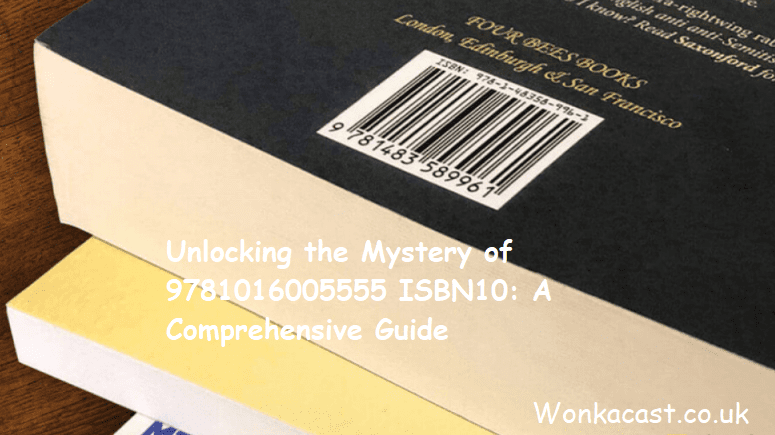In the world of literature and publishing, the International Standard Book Number (ISBN) serves as a unique identifier for books, ensuring easy cataloging and identification. Among these identifiers, 9781016005555 ISBN10 stands out as an important code that book lovers, retailers, and publishers alike should understand. This blog aims to delve deep into the intricacies of the ISBN system, particularly focusing on the ISBN-10 format, its significance, and how it relates to 9781016005555.
Understanding ISBN: A Brief Overview
The ISBN system was introduced in 1970 to provide a standardized method for identifying books. It helps booksellers, libraries, and distributors efficiently manage their inventory and sales. The ISBN is typically composed of 10 or 13 digits, where:
- The first part indicates the country or region.
- The next part identifies the publisher.
- The following segment signifies the title.
- The final digit is a check digit used to verify the number’s accuracy.
ISBN-10 and Its Importance
The ISBN-10 format comprises 10 digits and has been widely used until the transition to the 13-digit ISBN-13 system in 2007. The 9781016005555 ISBN10 code is significant for several reasons:
- Identification: It allows for easy identification of a specific book edition or format.
- Inventory Management: Retailers and libraries can quickly find and manage stock.
- Sales Tracking: Publishers can track sales effectively using this unique identifier.
The Structure of 9781016005555 ISBN10
Breaking down 9781016005555 ISBN10, we find several components that together form a complete identification system:
- 978: This prefix indicates the book is part of the ISBN-13 system.
- 1: This digit designates the English language group.
- 016: This segment identifies the specific publisher.
- 005555: This part relates to the title and format of the book.
- Check Digit: The final digit serves as a verification number.
This structured approach ensures that each book can be identified uniquely across the globe.
Transition from ISBN-10 to ISBN-13
While the ISBN-10 system served its purpose effectively for several decades, the need for a more expansive numbering system led to the introduction of ISBN-13. The transition occurred to accommodate a growing number of books and to streamline the cataloging process. The 9781016005555 ISBN10 is often seen alongside its ISBN-13 counterpart, which begins with 978 or 979, ensuring that both formats are recognized in the market.
Why 9781016005555 ISBN10 Matters
For avid readers, collectors, and bibliophiles, understanding the significance of 9781016005555 ISBN10 can enhance their book-buying experience. Here are some reasons why this code is important:
1. Facilitates Research:
Knowing the ISBN helps in researching books online, finding accurate editions, and avoiding counterfeit copies.
2. Improves Purchasing:
Retailers can assist customers better when they search using ISBN codes, making it easier to locate specific titles.
3. Enhances Library Services:
Libraries rely on ISBNs for cataloging and managing their collections, ensuring patrons can find the books they seek.
How to Use ISBN Codes Effectively
1. Searching Online:
Use the ISBN code when searching on platforms like Amazon or Google Books to find the exact book edition.
2. Cataloging Personal Libraries:
For those building their own collections, noting the ISBN can help track purchases and avoid duplicates.
3. In Academic Settings:
Students and researchers can utilize ISBNs to ensure they are referencing the correct editions in their bibliographies.
Common Misconceptions About ISBN
Many people harbor misconceptions regarding ISBNs. Here are a few clarifications:
Misconception 1: ISBNs are the same as the book title or author name.
- Clarification: ISBNs are unique identifiers that do not relate directly to titles or authors. They merely serve as a cataloging tool.
Misconception 2: All books have an ISBN.
- Clarification: Not all books, especially self-published or older editions, may have an ISBN. However, having one is highly recommended.
Misconception 3: ISBNs are only necessary for physical books.
- Clarification: E-books and audiobooks also benefit from having ISBNs for better distribution and sales tracking.
The Future of ISBN
As the publishing industry evolves, so too does the ISBN system. With the growth of digital media and self-publishing, the ISBN remains a crucial tool for organizing and selling books effectively. The continued relevance of 9781016005555 ISBN10 is evident, even as the industry transitions to digital formats and alternative distribution methods.
Historical Context of ISBNs
Provide a brief history of the International Standard Book Number (ISBN) system, explaining its inception in the 1960s and its evolution over the decades. This background can help readers appreciate the importance and necessity of ISBNs in the publishing industry.
The Role of ISBNs in E-books
Discuss how ISBNs are crucial for e-books and digital publications. Explain how publishers assign unique ISBNs to different formats of the same title, allowing for better tracking and sales analytics in the digital realm.
ISBN Assignment Process
Outline the process of how publishers obtain ISBNs. Explain that publishers can apply for ISBNs through their national ISBN agency and what the implications are for self-publishers in terms of purchasing their own ISBNs.
ISBNs and Copyrights
Clarify the relationship between ISBNs and copyright law. While an ISBN does not grant copyright, it plays a significant role in the distribution and identification of copyrighted works, allowing for better management of intellectual property.
Resources for Tracking ISBNs
Provide readers with resources and websites where they can look up ISBNs to verify books, find bibliographic information, or see how many editions exist. Websites like ISBNdb, WorldCat, and Google Books can be valuable tools for readers and collectors.
Conclusion
In summary, the 9781016005555 ISBN10 is not just a string of numbers; it is an essential part of the literary world, allowing for effective identification, sales tracking, and inventory management. Understanding how to use ISBNs can enhance your experience as a reader, collector, or publisher. Embrace the power of the ISBN and unlock the world of literature with ease!
Final Thoughts
As we conclude our exploration of 9781016005555 ISBN10, it is essential to recognize that this code represents more than just a series of numbers. It symbolizes a structured system that enhances the way we interact with books, making it easier for readers, collectors, and professionals in the publishing industry to find and manage literary works. Understanding ISBNs, particularly the 9781016005555 ISBN10, empowers you to navigate the literary landscape with confidence. Embrace the knowledge gained from this guide and appreciate the role that ISBNs play in your reading journey.
Call to Action
Now that you’re equipped with valuable insights about 9781016005555 ISBN10, it’s time to take action! Here are some steps you can follow:
- Explore Bookstores: Use ISBNs when searching for specific books at your local bookstore or online. Discover how this code simplifies your search.
- Build Your Library: If you’re an avid reader, consider cataloging your personal library using ISBNs to avoid duplicate purchases and enhance your collection.
- Share Knowledge: Inform fellow book lovers about the significance of ISBNs and how they can utilize them to improve their reading experience.
- Engage in Discussions: Join online forums or book clubs where you can discuss your favorite books and the importance of ISBNs in literature.
- Stay Informed: Keep up-to-date with changes in the ISBN system and how they affect the publishing industry. Understanding these developments can enhance your role as a reader or writer.
Embrace the world of books with confidence and let ISBNs guide your literary adventures!
FAQs
1. What does ISBN stand for?
ISBN stands for International Standard Book Number, which is a unique identifier for books.
2. What is the difference between ISBN-10 and ISBN-13?
ISBN-10 consists of 10 digits, while ISBN-13 includes 13 digits, accommodating more books and improving cataloging.
3. Do all books have an ISBN?
No, not all books have an ISBN, especially self-published or older titles. However, having an ISBN is recommended for better identification.
4. How can I find a book using its ISBN?
You can search for a book by entering its ISBN in online bookstores, libraries, or book databases.
5. Is there a cost associated with obtaining an ISBN?
Yes, publishers typically pay a fee to obtain ISBNs from official agencies, though self-publishing platforms may provide them for free.








I’m extremely impressed with your writing talents and also
with the layout in your weblog. Is that this a paid subject or did you modify it yourself?
Either way keep up the nice high quality writing, it’s uncommon to look a great blog like this one these
days.
Thank you so much for your lovely words! 😊
I customized everything myself to match my style. Really happy you’re enjoying it — stay connected for more!